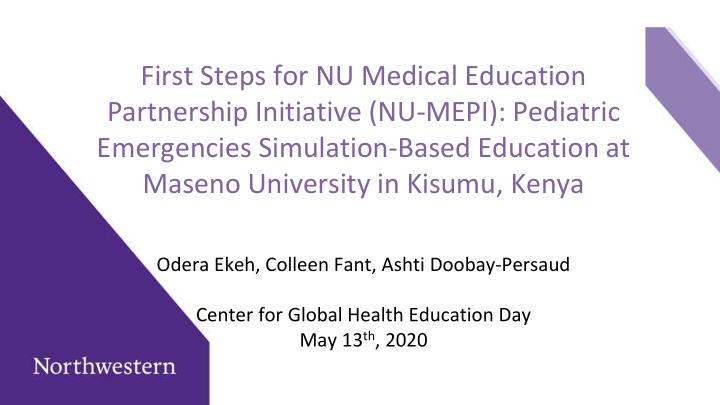



First Steps for NU Medical Education Partnership Initiative (NU-MEPI): Pediatric Emergencies Simulation-Based Education at Maseno University in Kisumu, Kenya Odera Ekeh, Colleen Fant, Ashti Doobay-Persaud Center for Global Health Education Day May 13 th , 2020
Background Pediatric Emergency Medicine • Medical specialty that does not exist in many parts of the world • In low- and middle-income countries (LMICs), care for acutely ill children is done by providers with limited emergency medicine or dedicated pediatric training Simulation-based Education • Widely recognized tool to teach medically challenging and emergent scenarios • Allows participants to gain experience and preparation in a supervised environment without compromising patient safety
Objective The inaugural NU-MEPI project is with Maseno University in collaboration with Jaramogi Oginga Odinga Teaching and Referral Hospital (JOOTRH) to build an emergency medicine pediatric simulation training program
Method: Kern Approach Kern, D. E. (2016). A six-step approach to curriculum development. P. Thomas, D. Kern, M., Hughes, & B. Chen, Curriculum development for medical education, 5-9.
Implementation and Results Step 1: Problem Identification and General Needs Assessment • Need for further pediatric specialty training – Faculty and trainee- clinical, research, and education development • Stakeholder meetings occurred with key informants at multiple institutional levels across both Maseno and JOOTRH Step 2: Targeted Needs Assessment • Specific simulation case content topics • 6 th year medical students as target learners • Future directions for research and education activities • Utilization of simulation lab and evaluation implanted through covert clinical observations
Next Steps • Translate assessments into specific learning goals and objectives • Determine educational strategies • Implement the simulation program (virtual)
Thank You Special thanks to the Strohm Family, Maseno University and JOORTH
Recommend
More recommend